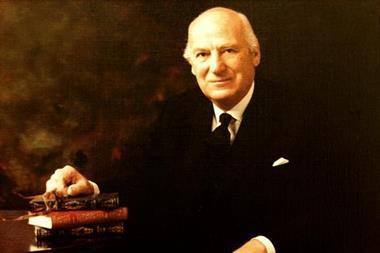The development of the professional broker in the UK can be traced back to the 16th century and the emergence of marine insurance. Lauren MacGillivray looks at how the industry has evolved, and the pressures faced by brokers today
The fact that brokers are still sometimes referred to as marine and non-marine is a little like “describing all women as non-men”, quips one global broker. But it’s also a poignant reminder of the broker’s beginnings, and how far the profession has come.
Marine, which is the earliest known class of insurance as a business, can be traced to Italy in the 13th century. But the UK made its mark internationally early on, with marine available in England by 1500 and 30 sworn brokers in London by 1574.
With London booming as a trade centre by the 17th century, there was a growing demand for ship and cargo insurance, and Lloyd’s coffee house became the place where ship owners met with underwriters to get marine cover.
How things have changed. Lloyd’s, now a metal fortress at One Lime Street and closed to the public, still handles marine and other specialist insurance. But brokers outside of Lloyd’s now hold their own across the UK, arranging everything from home and motor to employers’ and product liability.
“The fact that in London we talk about marine, and everything else is non-marine, infuriates the non-marine brokers,” Richard Close-Smith, an executive director within the marine division of Willis, says. “But it tells you that there was a time when marine was a bit more important than it is today. Clearly, marine is not as dominant as it was. But it remains a real part of the overall insurance picture.”
Captains of industry
In the early years of marine insurance, it wasn’t uncommon for people to end up in the profession after having first-hand experience with ships.
Sir William Garthwaite is a former Lloyd’s insurance brokerage, named after a ship owner and sugar planter, who gained notoriety following his service to the Admiralty during World War I.
Ian Crumpen, now owner of Nautical Insurance Services in Leigh-on-Sea, Essex, recalls working for the Lloyd’s broker 35 years ago. His boss was a senior insurance technician who had also previously served in the navy, during the Second World War. Crumpen remembers that he had worked on supply ships that sailed between the UK and America during the North Atlantic convoys, making harrowing journeys and dodging German U-boats.
“From a junior’s perspective, it was quite fearsome to be under the control of someone who’d seen such horrific action,” Crumpen says. “It was my first job and you can imagine: there I was working for this old sea dog. He was a tremendous character and ran the office like a ship.”
Crumpen, now 54, was 19 years old at the time. He remembers that, in addition to broking, he and his colleagues were to never be late, to wear clean shoes, and make sure they didn’t have any dirt under their fingernails.
Eventually, Crumpen went on to work for several other brokers before leaving commercial marine to open his own yacht and motorboat firm 18 years ago. The latest storm for his business to weather is the credit crunch: people aren’t buying boats worth up to £10m like they used to.
Losing steam
Navigators & General (N&G), the UK’s leading pleasure craft insurer and a member of the Zurich Group, confirms a slowdown in the number of new enquiries in the mid-range (£15,000-£250,000) yacht and motorboat market in the latter half of 2008.
A spokesman for the firm says that this appears to mirror the trends in boat sales, which is bound to have an impact on premiums for 2009 as the market becomes more competitive.
As you might expect, the commercial side of things is also taking a battering from the economic crisis. Rates are hardening but ship owners are going through desperate times, with the value of their ships plunging. +
“World trade is also plunging, so there’s less cargo insurance,” Close-Smith says. “As a result, although the marine underwriters may feel able to charge a bit more, I think their customers are so weakened that there won’t be as much business to play with as there was before.”
One illustration of how hard times are is the number of cape-sized bulkers – the big ships
that take bulk cargos around the Cape of Good Hope – that are on order (not yet built). In 2003, the number on order represented 15% of the world fleet. But in March of this year, on-order bulkers represented 150% of the world fleet, at a value of $540bn (£370bn). And no one wants them.
“There are a huge number of ships on order in shipyards, mainly in the Far East, but they’re not going to happen,” Close-Smith says. “Ship owners who’ve maybe put down a 10% deposit on a ship are not going to build it. If it was ordered for $100m, and yet it’s only going to be worth $50m, you’d rather kiss $10m goodbye than order something for $100m and find it’s only worth $50m.”
Great adaptations
Harsh economic conditions and a formidable regulatory structure mean that brokers have to be prepared for the challenge.
Close-Smith understands how the industry has changed over the years. “When I started in the London market 35 years ago, working with Willis, it was much easier to start your own little firm of marine insurance brokers than it would be today,” he says. “It doesn’t mean people won’t start up new brokers, but the price of entry into the market in terms of compliance, FSA regulations and so many other things, has made it more difficult.”
This is why regional brokers have honed in on commercial business for small and medium-sized enterprises (SMEs) – a niche that has been somewhat shielded from global brokers and other threats.
Crumpen believes that the discipline he learned early on has helped him thrive in an industry that has completely transformed from the boom days. He has survived thanks to new technologies that allow him to run a yacht and motor cruiser binding authority facility, via agreements with mainly Lloyd’s syndicate Amlin, as well as Navigators & General.
“We’re in a niche business – we’re probably one of the last few remaining independent insurance brokers specialising in one product, such as pleasure craft,” he says. “There’s been consolidation by the big brokers buying up other brokers. But there’s still room in the market for a small specialist that gives personal service.”
Early days
With such a rich history, marine broking still carries a certain amount of romanticism. But since its creation, a huge diversity of business for brokers has emerged. Right after marine came fire insurance, with the Fire Office established in London by Dr Nicholas Barbon in 1681.
With water and fire taken care of, then came hailstorm cover in 1842, livestock in 1844, personal accident in 1848, plate glass in 1852, employers’ liability in 1880, and burglary in 1887. More recently to the broker smorgasbord came motor insurance, introduced into the UK around 1896.
The professional broker role emerged early on, out of the underwriters’ need for an intermediary to handle the clients and present to them the relevant information in a clear and standardised way. (See box, ‘The broker’s beginnings’.)
They also became an important part of the accounting system, because underwriters didn’t want to have to chase individual ship owners for premiums. As each new area of insurance emerged through the decades, a broker has been there, providing a vital conduit between insurers and consumers.
Times like these
With a career spanning almost four decades, Biba’s Peter Staddon talks to Lauren MacGillivray about his broking days at Lloyd’s, and how today’s professionals can thrive amid challenging times
It’s common for those working in insurance to say they “fell into it”. But it’s more unusual to hear someone call their start in the profession as a “silly situation”, as does Peter Staddon, Biba’s head of technical services.
Staddon, now 54, started out as a broker straight from school, when he was just 16. He was asked to go and see a Mr Harris in Ibex House, and wandered into the building, which had 70 firms. He was passed along to numerous different offices before he landed a job with marine insurance broker Seascope.
When Staddon started there in 1971, the business – which had been founded a year earlier – was expanding, and he was the first non-insurance person to join. Now a chartered insurance broker, he believes that qualifications can help a broker stay ahead of the game.
“I think more brokers are now trying to get these qualifications and I think Lloyd’s has been instrumental in saying that if you are dealing with this, you need to have some sort of professional qualification,” he says.
But Staddon also says “anoraks” who enter the profession from school are still essential. “We do need [graduates] because they will probably be the innovators of tomorrow and they might well be good for a leadership role. But you need good people with A-levels to come in, because they need to understand the real dynamics. You need to get inside and understand what it’s all about.”
Staddon left Seascope in 1986 to join Edward Lumley, in order to expand his expertise into non-marine, and then moved on to a couple of other brokers before joining Biba in 1996.
He still has fond memories of Lloyd’s from his broking days. “There was a thing in Lloyd’s called bomb alley,” he recalls, “which was where a lot of marine insurers could write non-marine lines; they’d write terrorism risks. It was great; it was one of these places where a name just came up, like China Town or Little Venice.”
Carpe diem
Staddon remains a strong advocate of the London market. He says that, rather than using a non-UK based insurer and worrying about regulatory and other hassles, brokers might want to consider going through Lloyd’s instead.
He also advises regional brokers with large clients to consider captives. “If I can get some regional brokers to get their big clients to think about a captive, then the conventional market in the UK is going to lose income and they’re going to have to look for alternative sources,” he says. “Therefore, [insurers] might start writing risks they might not have necessarily written. And Lloyd’s is no different.”
Staddon’s fighting spirit is representative of the current generation of regional brokers in that anything is up for consideration. With competition from consolidators and aggregators, and with commission rates under fire, innovation has become the key to survival.
He believes one area where provincial brokers are falling short is succession planning – something he says was done better in the 1970s.
“When I was 21, my director called me into his office and said, ‘Congratulations, you’re 21, what are you doing with your life? Do you still live at home?’ I said, ‘Yes’, and he said, ‘I think you need to become a shareholder.’ So I became a shareholder of Seascope.”
Commission disclosure is another area where there have been sweeping changes. In the “old days”, it simply wasn’t an issue. But now that it is, Biba has spearheaded a market-led solution.
“What we’ve done here is that [a client] has the right to ask [what a broker’s commission rate is],” Staddon says. “What we don’t want to do is put it in their face, because there’s no reason for it. We want to try and move it away from the day-to-day contact between the client and the broker into a much more senior position.”
Go with the flow
Time will tell if commission disclosure remains unregulated. But just like the marine industry has changed so drastically, nothing stays the same forever. Staddon, ever an ideas man, is optimistic that innovation can still play a part in marine.
“If global warming is inevitable, should we not start thinking about Peterhead in Scotland?” he suggests. “The way to get to Japan is not down and around the bottom of the Cape, it’s over the top. That would be a route in 50 years’ time if global warming continues.”
A neverending enthusiasm and willingness to bend and flex to new conditions is what keeps Staddon still a broker at heart. He considers himself lucky in that he had great mentors - even those who took a non-traditional approach. In the late 1970s, for example, Seascope was pitching for a couple of government contracts. It was told that if it gave more than a 3% pay increase across the company that year, then it wouldn’t get the contract. So, the Seascope boss at the time gave all the managers company cars, and all those on low salaries got large pay increases.
“I got a 9% pay increase that year,” Staddon says. “It didn’t bust the government’s requirement because the 3% overall wasn’t breached.”
He concedes that brokers are facing increasing challenges, such as direct writers. “I’ve got some real issues with insurance companies that will turn around and say, ‘The base model for a direct writer is this, yet the broker is this plus 80%.’ How does that work?
“The only reason you’ve got direct writers is because you’ve used the profits that you’ve made through brokers to fund the innovation of direct writers. So basically you’re trying to take the food out of the broker’s mouth, and I have real issues about this.”
But he adds: “I remember one person from an aggregator site defined the broker as the ‘death rattle of a dying breed’. I don’t believe that, because I think brokers are innovators of the extreme. They will change things, always be there for the client, and know how to work the market.”
BIBA’s roots and manoeuvres
Biba, the largest broker organisation in the UK, owes its creation to Lloyd’s Insurance Brokers Association (Liba), which was formed in 1910 specifically to look after the interests of Lloyd’s brokers.
Following the Insurance Brokers (Registration) Act 1977, Liba agreed to join with the other insurance broker trade bodies – the Corporation of Insurance Brokers, Federation of Insurance Brokers and Association of Insurance Brokers – to form the British Insurance Brokers’ Association (Biba).
In 1988, following the introduction of the Financial Services Act 1986, Biba extended its membership to include independent financial advisers, and became the British Insurance and Investment Brokers’ Association (Biiba).
Then, in 1999, Biiba removed the word ‘Investment’ from its title, reverting to the name Biba. It now has around 2,400 members including 160 London market brokers.
Meanwhile, Liba, which had been renamed the London Market Insurance Brokers’ Committee (LMBC), remained separate for matters affecting Lloyd’s brokers. In January 2009, a breakaway group called the London & International Insurance Brokers’ Association (Liiba) formed to handle all the functions previously assumed by the LMBC. Liiba will still work with Biba on an ad hoc basis.
The broker’s beginnings
As soon as an insurance marketplace was established, it became difficult to allow the public to access the underwriters. Underwriters want information presented in a certain format, and by people with integrity in whom they can trust. So intermediaries were a natural development.
“Underwriters want to have business written in a relatively standard way so they can concentrate on judging the strengths and weaknesses of the case without having to deal with things like taking ship owners to dinner three times a week before they do business,” Richard Close-Smith, of Willis, says. “Underwriters don’t want to get sucked into all that; they just want to analyse facts. So that’s probably the point at which the brokers came in.”
Going provincial
So what about regional brokers, and what is their place in the pecking order?
“You could say Lloyd’s did have its feet in the regions, because you’d get some of the major ports around the West Coast going all the way up from North Wales into Scotland. Those people would want to make sure they had cover,” Peter Staddon, Biba’s head of technical services, says.
But he adds that telecommunications hadn’t evolved at that stage; and parochialism has always been a factor. “I dare say Lloyd’s would like to say, ‘Yes, we were instrumental in the formation of brokers’,” he says. “But brokers would’ve been born out of the need of the regional people’s requirements. The same is said for today; it’s just that we’re using technology whereby we can access a wider market for our clients.”
However, there’s still a lot of crossover between the London market and regional brokers.
Staddon comments: “There’s not really a dividing line as such. A lot of people who deal with wholesale reinsurance would probably think, ‘We’re different from domestic retail.’ But many misunderstand the word retail – they think it’s home, motor. No it isn’t; it’s domestic commercial, and home and motor.
“But Lloyd’s has opened the doors, which means more and more regional brokers will have access into Lloyd’s. So they’ll be looking at Lloyd’s in a different light and using it for alternative markets. The real innovators out in the industry are looking for different markets. They’re looking for strategies but, more important, they’re looking for stability. And Lloyd’s is a very good market.”
Downloads
Biba 09
PDF, Size 2.44 mb
Hosted by comedian and actor Tom Allen, 34 Gold, 23 Silver and 22 Bronze awards were handed out across an amazing 34 categories recognising brilliance and innovation right across the breadth of UK general insurance.













































No comments yet